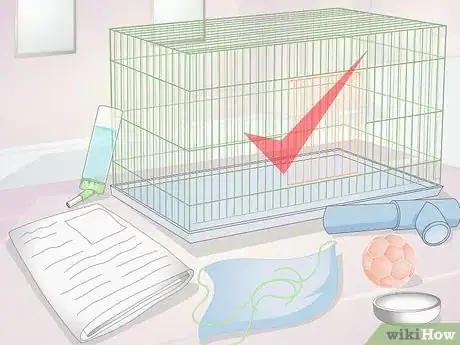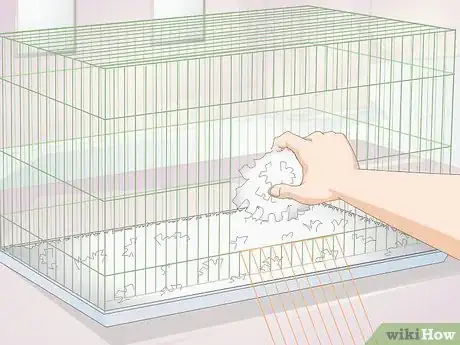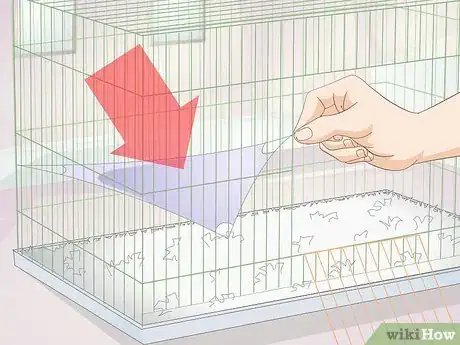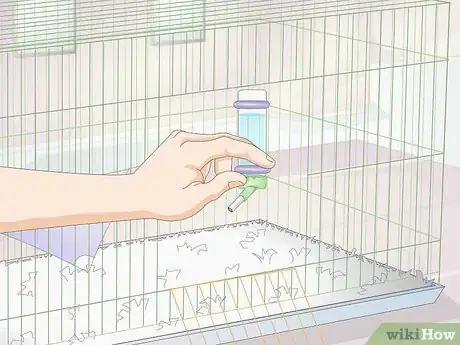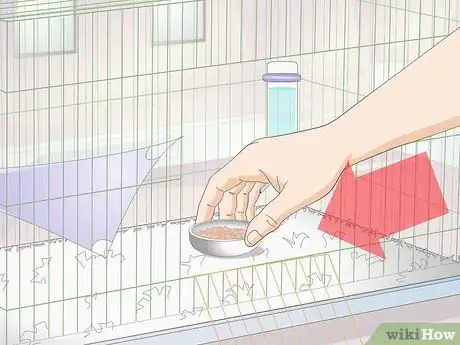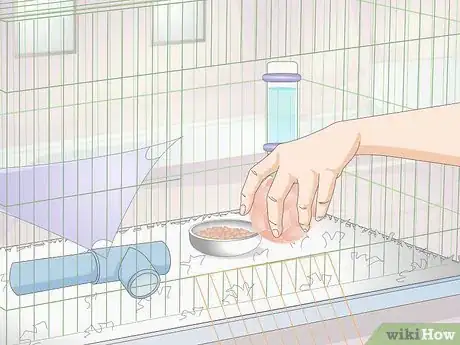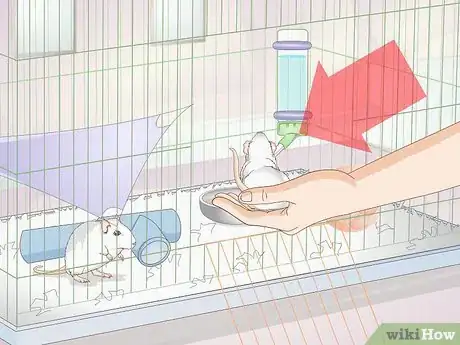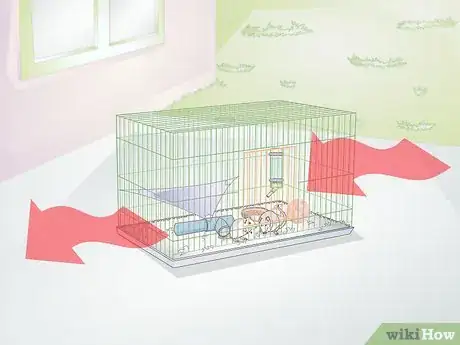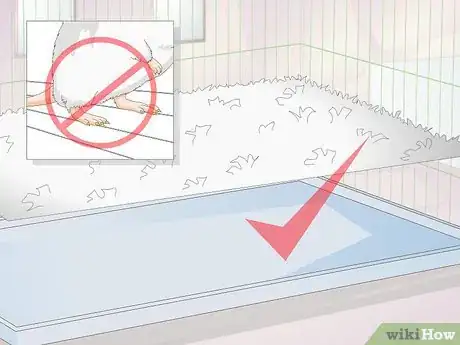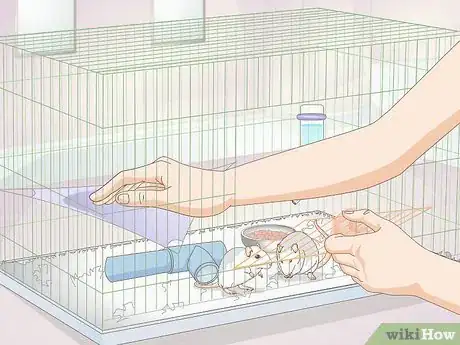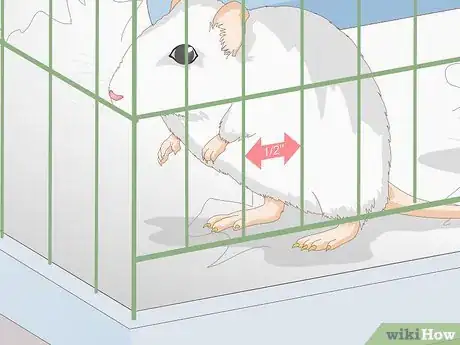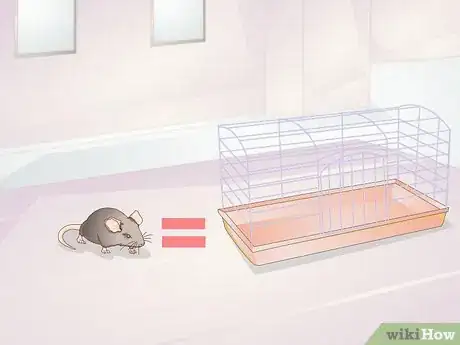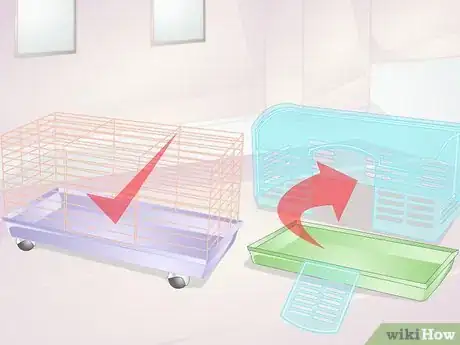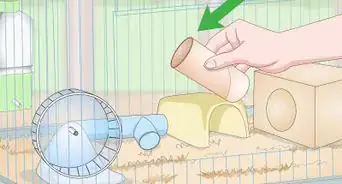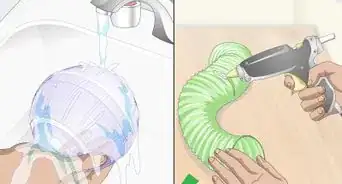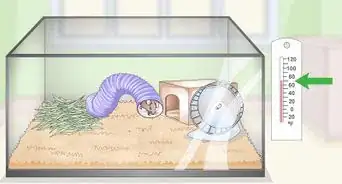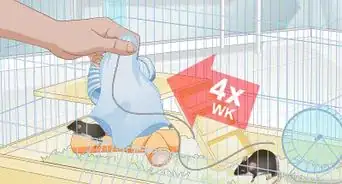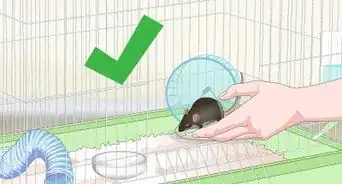This article was co-authored by Brian Starr. Brian Starr is a Rat Specialist and Breeder and the Owner of OC Dumbos out of Central Florida. As America’s only breeder of pet Roof Rats, Brian and OC Dumbos specialize in rat breeding, training, and care. Years of experience and several generations of careful breeding have allowed Brian and OC Dumbos to create a line of tame Roof Rats, bred to make friendly, fun pets. In addition to offering rat accessories and training resources, OC Dumbos also offers free Roof Rat adoptions.
There are 8 references cited in this article, which can be found at the bottom of the page.
This article has been viewed 45,259 times.
Pet rats can be a fun and unusual pet. Since rats are usually caged as pets, it’s important to provide your pet rat with a safe and comfortable cage to live in. In order to set up a good cage for your pet rat, it’s important to provide for their cage, make them feel safe, and choose the right size cage as your rat grows up. Having a pet rat can be rewarding, but you’ll want them to feel safe and comfortable when living at your pet.
Steps
Getting Supplies for Your Rat's Cage
-
1Prepare your supplies for the rat cage. Before you put the rat into the cage, make sure to have all the supplies you plan to put into it. That way your pet rat will not be disturbed from its cage. Consider including the following supplies:[1]
- Dry bedding
- Hammocks
- Small water bottle
- Food bowl
- Toys such as ropes, tubes, baskets, and boxes
- Litter trays
-
2Fill your cage with nice warm bedding. Rats can generally handle cold temperatures well, but it’s important to give them good bedding. Use materials such as paper or cloth for the best bedding, but make sure to avoid aromatic cedar or pine, since it can be dangerous to your pet rat.[2]
- Shredded paper is a good bedding material for your rat, though it will need to be changed often. You can also use cloth bedding, such as old clothes, as long as the material does not unravel easily.
- Stay away from aromatic cedar or pine. This bedding can damage your rat’s liver and respiratory system.
Advertisement -
3Put a rat hammock in the cage. You can either purchase or make a rat hammock. Pet rats love cuddling in these hammocks, which can also keep them warm during the colder months.[3] [4]
- If you want to make a rat hammock, you can use fleece or t-shirt fabric cut into squares or rectangles. Hang the hammock with safety pins, so the hammock is secured.
- You can also buy rat hammocks at many pet stores. Rats will occasionally chew in their hammocks, so it’s important to have the hammocks be made of materials that cannot be easily chewed through. Otherwise, it’s possible your rat could fall from the hammock onto the floor of the cage.
-
4Attach water bottles to the cage. Rats will knock over any water bowls, so it’s important to attach a bottle to the side of the cage. Your water bottle should be changed on a regular basis, since rats need plenty of water.[5]
- Secure your water bottle to the side of the cage so it won’t fall. Rats will chew on the water feeder, so place a protective covering such as a can or small plastic bowl on top of the bottle if the rats can get to the bottle.
- It may even be useful to have multiple water bottles, especially if you may not be around your rat on a consistent basis. This way they will always have plenty of water.
-
5Fill food bowl and place it in the cage. Rats will knock over any light food bowls, so make sure the food bowl is heavy and low to avoid spillage. You can also consider a mounted food bowl.
- Food bowls can be easily spilled, so make sure it is secured in the cage. You can use a food hopper that dispenses food if spillage is a problem for your pet rat.
- Have separate bowls for wet and dry food for your rat. Additionally, remove any perishable food so it does not begin to go bad while in the cage.
-
6Bring plenty of toys for your rat. Supply your pet rat with a variety of toys, including toys that hang off the top of the cage, toys on the floor, and mental stimulation toys. Rats need something to do while in the cage, so mental stimulation toys are the most important.
- Put in a wheel runner for your pet rat. Female rats tend to run more than male rats, but both gender should use it.
- Give plenty of climbing toys. Rats love to climb, so make sure they are able to climb up ropes and ladders while in their cage.
- Provide your rats with digging options as rats love to dig. If your cage doesn't have a deep base to contain the substrate, you can use a large cardboard box with a suitable digging material such as paper bedding, shredded paper, or coco coir.
- Rats need plenty of mental stimulation, so toys like mazes, toilet rolls, and paper balls can be great for them. They like solving puzzles, so any toys that make them do that can be beneficial for your pet rat.[6]
- Make sure that the toys are safe for your rat to chew on. For example, toys made out of plastic might not be safe to eat.[7]
-
7Place your rats in their new home. Let them roam around and get used to things. Don't hold them for their first 2-3 days while they are getting used to their cage and surroundings.
- It takes rats awhile to get comfortable. However, they should settle into their new rat cage pretty quickly.
- Your rat may need additional supplies once they get in the cage. Observe your rat to see if you need anything else.
Making Your Rat Safe in Their Cage
-
1Provide good ventilation for your rat. Your rat's cage should give your rats plenty of ventilation. Don't use aquariums or fully enclosed cages, but instead use wire cages with plenty of open air.[8]
- Aquariums and plastic enclosures keep in dust and ammonia in the cage. These can make your rat sick because they are not getting enough fresh air.
- Wire cages, made of either plastic or metal, are better for giving your rat plenty of fresh air. A solid body bottom, rather than wire bottom, can be better for your rat's feet.
-
2Protect your rat's feet. A solid body bottom to your cage can protect your rat's feet. If you have a wire floor to your cage, consider getting a solid body covering for the bottom of your cage.
- If you have a wire cage bottom, your pet rat can contract bumblefoot. This condition can cause swelling and infection in your pet rat's feet.
- You can buy plastic laminate, which is used on kitchen floors, in wire cages to protect your pet rat's feet. This material can be purchased at most hardware stores.
-
3Make sure the cage can be cleaned easily. Plastic cages can usually be cleaned easily when necessary without any damage. If you get a metal cage, it's best to be Polyvinyl chloride (PVC) coated to avoid rust and general cage damage.
- If you have a plastic cage, make sure the plastic can be cleaned without cracking. Plastic cages that crack will not last as long as those that stay in good shape.
- Metal cages need PVC coating to avoid rust. However, PVC coating will still wear, but not as quickly or thoroughly as metal cages without finish.
-
4Have a cage that you can easily access. You should be able to reach into the cage and move around the cage supplies. Additionally, you want to be able to get your pet rat out safely without squeezing them.
- Shelves and doors should be easy for you to reach. Your rat should not be closed in by the size and shape of the cage.
- The door of the cage should easily pop open so you rat can come out or you can take them out. If you have to move your hand around too much to reach your rat, the cage may be too small and cause you to squeeze your rat when taking them out.
-
5Keep the bar spacing safe for your pet rat. In a wire cage, it's important for the bar spacing to be far enough apart to not cause your pet rat to get stuck. Additionally, you want the bar spacing to be small enough that your rat cannot escape.
- For baby rats, bar spacing of about 1/2 inch is ideal. For adult rats, up to 1 inch spacing between bars is better.
- Consider the size of your rat when choosing the bar spacing. You may need to get a bigger cage with different bar spacing as your rat grows up.
Choosing the Right Size Cage
-
1Get the best cage for your baby rat. If you get your pet rat as a baby, it's important to have a cage that fits their size. Don't get a cage that's too big, since they may be able to escape through the bars.[9]
- Baby rats are about 1.25 inches at birth. They are also blind and without fur. By two weeks, they can see and begin growing fur.[10]
- A cage that is too large for a baby rat can be intimidating for them.They want to feel safe and comfortable, but may feel exposed to predators in a large cage.
- Cages for baby rats will not last long. After about three months, they will outgrow a small cage. You can use a rat carrier or travel housing as your starter cage for your baby rat.[11]
-
2Purchase a large cage for your adult rats. Rats like to play, so they need plenty of space. Otherwise, they may become defensive towards you and their surroundings.
- Your cage should supply about 2-2.5 cubic feet per rat. However, this is a good minimum, but the larger the cage, the better it will be for the rat. You can use a rat cage calculator to check how many rats can comfortably live in your cage.
- You should be able to place plenty of toys and things to do in your rat cage without crowding it. If your rat's toys make your cage look cluttered, it may be time to get a larger cage.
- You don't necessarily need to get a bigger cage for 2 rats. Friendly rats usually sleep together in a hammock, and want to be next to each other.[12]
-
3Think about special circumstances for your rat cage. There may be some particular circumstances that dictate the type of cage you get. If you are in any of the following conditions, make sure to consider them in setting up your rat cage.
- You will need to clean the cage on a regular basis. However, if you live in an apartment, you may want to get a cage that can comfortably fit in the bathtub, since you will likely not be able to take it outside to clean it.
- Use an animal-safe disinfectant to clean your cage and make sure the cleaning products you use are not toxic. Avoid using scented cleaning products as rats have a sensitive respiratory systems that can easily get irritated.
- Children can stick their fingers in the cage and get bitten by your pet rat. Have a big enough bar size that your children will not be able to stick their fingers inside.
- A cage that's easy to take apart may be useful if you plan on moving. Cages can be a hassle to move if they cannot easily be taken apart. When they can't be taken apart, wheels on the bottom of the cage may be useful.
Expert Q&A
-
QuestionWhat is a good cage size for a rat?
 Brian StarrBrian Starr is a Rat Specialist and Breeder and the Owner of OC Dumbos out of Central Florida. As America’s only breeder of pet Roof Rats, Brian and OC Dumbos specialize in rat breeding, training, and care. Years of experience and several generations of careful breeding have allowed Brian and OC Dumbos to create a line of tame Roof Rats, bred to make friendly, fun pets. In addition to offering rat accessories and training resources, OC Dumbos also offers free Roof Rat adoptions.
Brian StarrBrian Starr is a Rat Specialist and Breeder and the Owner of OC Dumbos out of Central Florida. As America’s only breeder of pet Roof Rats, Brian and OC Dumbos specialize in rat breeding, training, and care. Years of experience and several generations of careful breeding have allowed Brian and OC Dumbos to create a line of tame Roof Rats, bred to make friendly, fun pets. In addition to offering rat accessories and training resources, OC Dumbos also offers free Roof Rat adoptions.
Rat Specialist & Breeder Pick up a multi-leveled cage that's around 2 to 3 ft (61 to 91.4 cm) by 2 to 3 ft (61 to 91.4 cm), and around 2 ft (61 cm) tall. Overall, make sure the cage is big enough for the rat to run around in.
Pick up a multi-leveled cage that's around 2 to 3 ft (61 to 91.4 cm) by 2 to 3 ft (61 to 91.4 cm), and around 2 ft (61 cm) tall. Overall, make sure the cage is big enough for the rat to run around in.
References
- ↑ Brian Starr. Rat Specialist & Breeder. Expert Interview. 27 April 2021.
- ↑ http://ratguide.com/care/environment/cage_bedding_litter.php
- ↑ http://www.ratfanclub.org/cages.html
- ↑ Brian Starr. Rat Specialist & Breeder. Expert Interview. 27 April 2021.
- ↑ http://ratguide.com/care/environment/cage_accessories.php
- ↑ http://ratsinaction.weebly.com/toys-and-games.html
- ↑ Brian Starr. Rat Specialist & Breeder. Expert Interview. 27 April 2021.
- ↑ http://www.northstarrescue.org/pet-care-information/pet-rat-care/138-a-guide-to-pet-rat-cages
- ↑ http://www.rmca.org/Articles/cagesize.htm
- ↑ http://www.ratfanclub.org/orphans.html
- ↑ http://www.northstarrescue.org/pet-care-information/pet-rat-care/138-a-guide-to-pet-rat-cages
- ↑ Brian Starr. Rat Specialist & Breeder. Expert Interview. 27 April 2021.
About This Article
Before you set up a cage for your pet rat, gather the supplies you’ll need, including dry bedding, a small rodent water bottle, a food bowl, hammocks, and toys. Additionally, make sure you choose a large cage with wire bars that allow for good ventilation. To start, fill your cage with plenty of paper or cloth bedding to keep your rat warm. Then, attach the water bottle to the side of the cage and place the food bowl securely in a corner. Rats love to cuddle in hammocks, so either buy one from a pet store or make one yourself by hanging a piece of fabric in a corner with safety pins. For more information from our Veterinary co-author, like how to clean your rat’s cage, keep reading!
